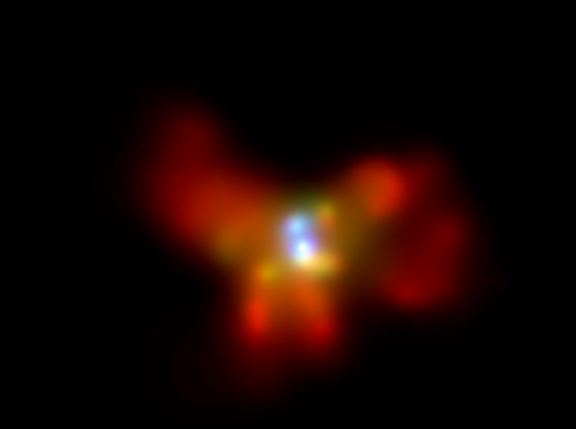
The clearest way to define distance is as “the amount of space between two points.” But how far is far? This short video compares distances from the very small to the very far, from the distance between gravitational waves to the distance to some of the farthest galaxies.
Check out the Virtual Choir Deep Field project to explore more on distance.
Cosmic Distances
In astronomy, distances are measured in units of light years, where one light year is the distance that light travels in a year—10 trillion kilometers. For historical reasons having to do with measuring distances to nearby stars, professional astronomers use the unit of parsecs, with one parsec being equal to 3.26 light years.
Astronomers compute the distance to remote galaxies (ones that are more than about 20 million light years away) with Hubble's law. According to Hubble's law, the universe is expanding in such a way that distant galaxies are receding from one another with a speed which is proportional to their distance. The recession causes the radiation from a galaxy to shift to longer wavelengths—the red shift. From a measurement of the red shift and the constant of proportionality, called Hubble's constant, astronomers can determine the distance to a galaxy.
One of the central problems of modern astronomy is to accurately determine Hubble's constant, which is a measure of the rate of expansion of the universe. At present it is known to an accuracy of about 20 percent, so we usually modify distances by saying "about 100 million light years," for example. We assume throughout this web site a value of the Hubble constant that corresponds to a recession velocity of 600 kilometers per second for a source at a distance of 30 million light years or 10 million parsecs (H0 = 60 km/s/Mpc).
Cosmic Look-Back Time

NGC 6240
The finite speed of light means that we must always be out of date, no matter how hard we strive to keep up with the times. Thus, the seemingly simple question - what is happening right now on the Sun? - cannot be answered by an observer on Earth, because it takes light 8 minutes to reach Earth from the Sun. For distant galaxies, the light travel times are even longer, so our information about the galaxy NGC 6240
The time in the past at which the light we now receive from a distant object was emitted is called the look-back time. When astronomers discuss events in distant objects, they take for granted that the actual event occurred earlier because of light travel time. It is similar to finding a series of photographs of a child in a 300 year-old time capsule. We could see how the child was developing 300 years ago, even though he/she would no longer be alive.
In the case of NGC 6240, the predicted merger of supermassive black holes has likely already occurred, perhaps 250 million years ago in NGC 6240 time. But we won't know about it for another 150 million years! See the following sample time line.
NGC 6240 sample time relative to Earth time:
450 million years earlier - Galaxies merged
400 million years earlier - Supermassive black holes are 3000 light years apart (Chandra Observation)
250 million years earlier - Black holes merged
Earth time:
50 million years ago: Galaxies merge Now: Observe Supermassive black holes 3000 light years apart 150 million years from now: Black holes merge
Try sorting the following objects by distance, dragging the object names up or down. Place the object nearest to us at the top, continuing on to the object farthest from us at the bottom. Press Submit to check your answers and learn more about each object.
More about the Images
Learn more
For information on Scale and Distance visit https://chandra.si.edu/photo/scale_distance.html
For information on Angular Measurement visit https://chandra.si.edu/photo/scale_distance.html
For an activity on Size and Color visit https://chandra.si.edu/micro/
